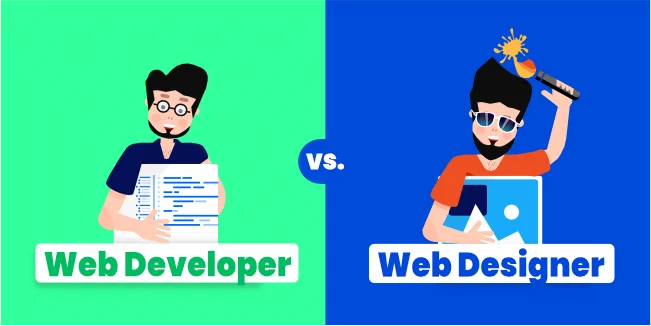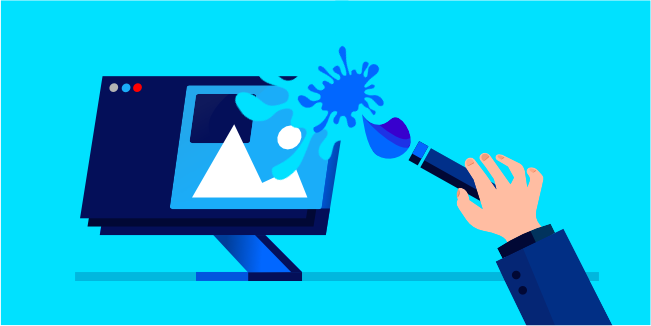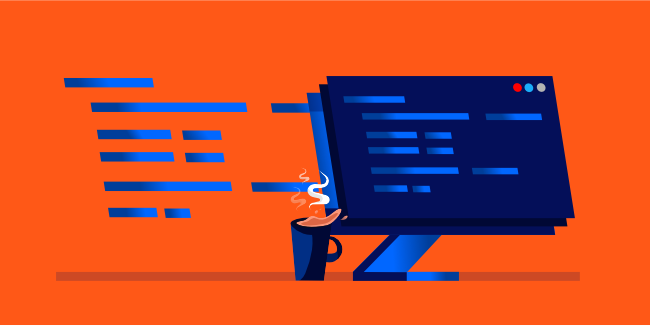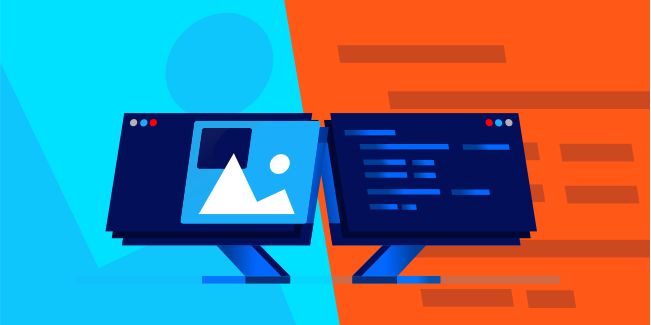Web Design vs. Web Development - Comparison

When you're just beginning to learn to code, it's only natural that you would be unsure of which career path is right for you. One of the first things students of our Discovery Workshops need to decide is whether they want to pursue web design or web development.
With the numerous ways to attain specialized expertise, it isn't easy to decide which way is best for you, especially if you're new to the tech industry. With that in mind, should you pursue web design or web development?
If you are interested in design, check out our article "Golden Rules of UX design," in which we present the well-known but fundamental principles of user experience design. Whether you choose web design or web development, you will surely find this helpful knowledge.
After reading this article, you will know to make an educated decision.
What is Web Design?

Skillful web design affects everything related to visual aesthetics and how easy it is to use a website, such as color scheme, layout, information flow, etc. Some abilities and tools that make web designers stand out from web developers are:
- Graphic design
- UI/UX design
- Layout/format
- Wireframes, mock-ups, storyboards
- Typography
Duties of Web Designer
A web designer's responsibility is to create a website's layout and visual aspects. It can include varied tasks such as creating graphics, text, illustrations, videos, audio files, and more.
Often, their goal is to make the site aesthetically pleasing and user-friendly and have a structure that encourages visitors to stay. Along with the general framework and layout, this includes thinking about elements that generate conversions and designing web pages to look consistent across different devices.
To remain current, web designers must be familiar with the latest trends and adhere to standards and best practices. Their work revolves around brand imagery, color palettes, fonts, etc.
Furthermore, a web designer has to think about how their designs will turn into lines of code. Designers plan a sitemap and design, which developers use as a guide to creating the final website.
Most web design companies offer post-launch support, like content updates, maintenance, monitoring services, and periodic performance tests.
Web Designers Types
The work of a web designer can be broadly categorized into the following types:
- User Experience (UX)
- User Interface (UI)
- Visual
If you're trying to figure out which web design niche is best for you, keep reading.
UX Designers
UX designers play a crucial role in creating websites that are enjoyable and easy to use. They focus on producing designs that put the user first, using data-based methods to conclude what works best. It includes plenty of research and experimentation to collect relevant data, which is then used as evidence for design decisions.
UI Designers
UI designers don't just create websites that look pretty. They also prioritize function over form. In other words, they make interactions on a website as easy and painless as possible for the user to encourage conversions.
Visual Designers
The title "visual designer" suggests someone who works with a website's layout and visual elements, which is correct. In other words, a visual designer must ensure the interface looks nice and is easy to use. This work combines certain aspects of both UX and UI design.
Most web designers rely heavily on a few tools to complete their work. The most important category of these tools is design and editing software like Adobe Photoshop.
Web Designer Needed Skills
Depending on their role and area of expertise, the skills web designers need to be successful can vary. That being said, some important skills for all web designers include:
- HTML and CSS knowledge
- Design tools and software
- Adhering to the set standards of web accessibility and design
- Branding, color theory, and typography
- Responsive and interaction design
- User journey mapping
- Conversion Rate Optimization (CRO)
- Wireframing and prototyping
In addition to technical skills, web designers need other abilities to be successful. For example, they must be able to communicate well with clients and manage expectations.
They should also know how to work on a team with people who have different roles, such as developers. It will help make sure that every project runs smoothly from start to finish.
What is Web Development?

Web development encompasses the coding powering of all websites, which can be divided into front-end and back-end components.
The client side of an application, also known as the front end, is code that determines how a website will display designs created by a designer.
Data management and handling lie on an application's back-end or server side. At the same time, the front end is only responsible for displaying that data.
The front-end developer's job is often the most similar to the web designer's. Some skills and tools that are traditionally seen as only belonging to the front-end developer are listed below:
- HTML/CSS/JavaScript
- CSS preprocessors (i.e., LESS or Sass)
- Frameworks (i.e., AngularJS, ReactJS, Ember)
- Libraries (i.e., jQuery)
- On-site search engine optimization (SEO)
Front-end web developers typically don't create mock-ups, select typography, or pick color palettes because the designer usually provides these. It's the developer's job to bring those mock-ups to life.
In other words, a background in UI/UX design is necessary to ascertain what the designer wants so that the developer can hand-pick the perfect technology. It will enable them to create a final product that achieves the desired look, feel and experience.
The back-end developer is responsible for the functionality and data on the back side of an application. They develop routing that allows information to move an app's front and back end. Listed below are some programming languages only a back-end developer would utilize:
- Server-side programming languages (e.g., PHP, Python, Java, C#)
- Server-side web development frameworks (e.g., Ruby on Rails, Symfony, .NET)
- Database management systems (e.g., MySQL, MongoDB, PostgreSQL)
- Authentication and security (e.g., OAuth, PassportJS)
- Servers (e.g., Linux, Apache, Express)
A full-stack developer is a web developer with expertise and experience in the front-end and back-end of a technology stack.
Front-End Web Developers
Front-end developers use HTML, CSS, JavaScript, and other languages to code the visual elements of a website that users will see. Front-end development is also known as client-side development. Because front-end developers focus on coding the visual aspects of a website design, there is often overlap and collaboration between front-end developer roles and web designer positions.
Back-End Web Developers
Back-end developers use sophisticated programming languages such as PHP, C#, Java, Ruby, and SQL to code the database and server. Back-end development encompasses all aspects of website creation happening 'behind the scenes, which visitors don't see when they visit a site.
Full-Stack Web Developers
Full-stack developers are responsible for a website's front and back end. They understand how these two sides interact and work together. In addition to coding web pages using HTML, CSS, and JavaScript, full-stack developers also set up servers, code Application Programming Interfaces (APIs), query databases, etc.
Web Designer Needed Skills
As mentioned, web developers must have particular technical abilities for their job descriptions. The bare minimum a web developer will require is:
- Testing and debugging
- Back-ends and databases
- Coding and programming languages such as HTML, CSS, JavaScript, and PHP
- JavaScript frameworks like jQuery
- Search Engine Optimization (SEO)
While it's helpful to have coding skills as a web developer, other practical abilities come in handy too. For example, problem-solving and analytical thinking can help with the debugging process. Additionally, communicating and collaborating productively is key for working with clients or other team members (like web designers).
Web Designer vs. Web Developer

Now that you understand the critical differences between a web designer and a web developer, let's take an even closer look at what sets these two roles apart:
- Designers worry about how a website appears and if users can figure out how to use it. At the same time, developers focus on making sure the website works properly and is organized well.
- Web designers create a website's visual mock-up and overall look, while web developers take care of the technical aspects to ensure the concept is possible. It includes coding and programming the site itself.
- Web developers must have technical skills, including comprehension of challenging programming languages and frameworks. They also need to be able to do research and analysis. In contrast, a web designer's role is less technical and more about a website's visual aspects and creativity.
- Some common web developer roles are front-end, back-end, and full-stack developers. Three main types of web design include UX, UI, and visual design.
- Web developers use common tools: coding libraries and frameworks, code versioning/issue tracking platforms (e.g., GitHub and Jira), hosting control panels and FTP clients, and CMSs. On the other hand, web designers typically utilize design editing software (e.g., Photoshop), a CMS (like WordPress), and a website builder (such as Elementor) - along with wireframing and prototyping tools.
- Web designers and developers have major website creation, development, and upkeep responsibilities. The success of a website depends on the collaboration between these two groups.
Developers usually focus on the technical aspects of a project, like programming and coding. In contrast, designers concentrate mainly on visual elements. Designers are crucial for a project's success as they manage the visual and conceptual elements required for an excellent UX and UI.
Final Words
Although they may sound similar, web designers and web developers have two significantly different job descriptions. Designers focus on a website's front-end and visible aspects that will affect its user-friendliness and how users perceive it aesthetically. Developers take all of the concepts given to them by designers and actualize those plans into functioning websites through coding language.
Before deciding whether you want to pursue web design or development, consider the various skill sets needed for each option. If you find yourself more interested in the technical side of things, web development might be proper for you. On the other hand, if you have a creative streak and enjoy working with branding and color theory, then a career in web design is probably your best bet.